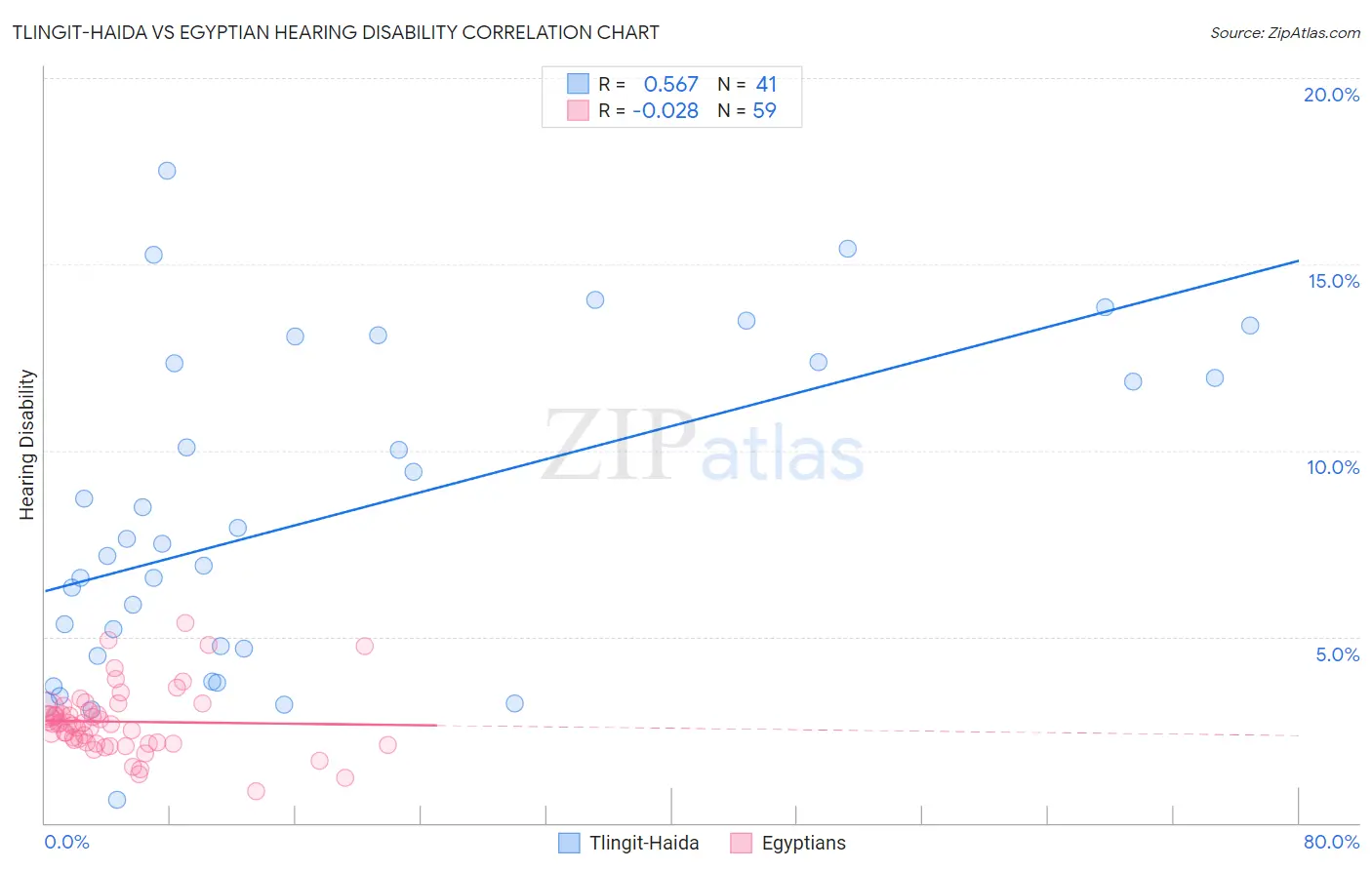Tlingit-Haida vs Egyptian Hearing Disability
COMPARE
Tlingit-Haida
Egyptian
Hearing Disability
Hearing Disability Comparison
Tlingit-Haida
Egyptians
4.8%
HEARING DISABILITY
0.0/ 100
METRIC RATING
344th/ 347
METRIC RANK
2.7%
HEARING DISABILITY
98.1/ 100
METRIC RATING
67th/ 347
METRIC RANK
Tlingit-Haida vs Egyptian Hearing Disability Correlation Chart
The statistical analysis conducted on geographies consisting of 60,852,790 people shows a substantial positive correlation between the proportion of Tlingit-Haida and percentage of population with hearing disability in the United States with a correlation coefficient (R) of 0.567 and weighted average of 4.8%. Similarly, the statistical analysis conducted on geographies consisting of 276,851,479 people shows no correlation between the proportion of Egyptians and percentage of population with hearing disability in the United States with a correlation coefficient (R) of -0.028 and weighted average of 2.7%, a difference of 78.1%.

Hearing Disability Correlation Summary
| Measurement | Tlingit-Haida | Egyptian |
| Minimum | 0.61% | 0.86% |
| Maximum | 17.5% | 5.4% |
| Range | 16.9% | 4.5% |
| Mean | 8.3% | 2.7% |
| Median | 7.5% | 2.7% |
| Interquartile 25% (IQ1) | 4.6% | 2.1% |
| Interquartile 75% (IQ3) | 12.4% | 3.0% |
| Interquartile Range (IQR) | 7.8% | 0.90% |
| Standard Deviation (Sample) | 4.3% | 0.89% |
| Standard Deviation (Population) | 4.3% | 0.88% |
Similar Demographics by Hearing Disability
Demographics Similar to Tlingit-Haida by Hearing Disability
In terms of hearing disability, the demographic groups most similar to Tlingit-Haida are Inupiat (4.7%, a difference of 2.7%), Tsimshian (4.7%, a difference of 2.9%), Navajo (4.6%, a difference of 4.5%), Pueblo (4.6%, a difference of 4.9%), and Choctaw (4.5%, a difference of 6.4%).
| Demographics | Rating | Rank | Hearing Disability |
| Dutch West Indians | 0.0 /100 | #333 | Tragic 4.3% |
| Aleuts | 0.0 /100 | #334 | Tragic 4.3% |
| Kiowa | 0.0 /100 | #335 | Tragic 4.3% |
| Creek | 0.0 /100 | #336 | Tragic 4.4% |
| Chickasaw | 0.0 /100 | #337 | Tragic 4.5% |
| Alaska Natives | 0.0 /100 | #338 | Tragic 4.5% |
| Choctaw | 0.0 /100 | #339 | Tragic 4.5% |
| Pueblo | 0.0 /100 | #340 | Tragic 4.6% |
| Navajo | 0.0 /100 | #341 | Tragic 4.6% |
| Tsimshian | 0.0 /100 | #342 | Tragic 4.7% |
| Inupiat | 0.0 /100 | #343 | Tragic 4.7% |
| Tlingit-Haida | 0.0 /100 | #344 | Tragic 4.8% |
| Alaskan Athabascans | 0.0 /100 | #345 | Tragic 5.3% |
| Colville | 0.0 /100 | #346 | Tragic 5.3% |
| Yup'ik | 0.0 /100 | #347 | Tragic 5.8% |
Demographics Similar to Egyptians by Hearing Disability
In terms of hearing disability, the demographic groups most similar to Egyptians are Immigrants from Africa (2.7%, a difference of 0.13%), Nicaraguan (2.7%, a difference of 0.17%), Immigrants from Belize (2.7%, a difference of 0.23%), Immigrants from Nepal (2.7%, a difference of 0.35%), and Peruvian (2.7%, a difference of 0.40%).
| Demographics | Rating | Rank | Hearing Disability |
| Immigrants | Egypt | 98.5 /100 | #60 | Exceptional 2.7% |
| Immigrants | Uzbekistan | 98.4 /100 | #61 | Exceptional 2.7% |
| Immigrants | Colombia | 98.4 /100 | #62 | Exceptional 2.7% |
| Indians (Asian) | 98.4 /100 | #63 | Exceptional 2.7% |
| Immigrants | Sri Lanka | 98.4 /100 | #64 | Exceptional 2.7% |
| Immigrants | Nepal | 98.3 /100 | #65 | Exceptional 2.7% |
| Immigrants | Belize | 98.2 /100 | #66 | Exceptional 2.7% |
| Egyptians | 98.1 /100 | #67 | Exceptional 2.7% |
| Immigrants | Africa | 98.0 /100 | #68 | Exceptional 2.7% |
| Nicaraguans | 97.9 /100 | #69 | Exceptional 2.7% |
| Peruvians | 97.7 /100 | #70 | Exceptional 2.7% |
| Central Americans | 97.7 /100 | #71 | Exceptional 2.7% |
| Afghans | 97.6 /100 | #72 | Exceptional 2.7% |
| Argentineans | 97.5 /100 | #73 | Exceptional 2.7% |
| Immigrants | Korea | 97.5 /100 | #74 | Exceptional 2.7% |